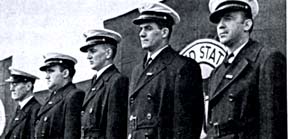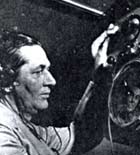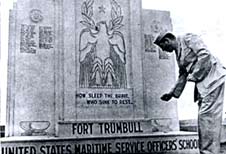Fort Trumbull, Connecticut
Maritime Officers Training School at Fort Trumbull graduated 15,473 officers in 76 classes between 1939 and 1946, when the operation was transferred to the U.S. Merchant Marine Academy.Fort Trumbull U.S. Maritime Service Officer Candidate School trains Deck and Engine men for important positions in our expanding American Merchant Marine
MAST Magazine May 1944
Deeply steeped in tradition and rich in the deeds of the men it trains today. That is Fort Trumbull where the U. S. Maritime Service's Officer Candidate school is located on the banks of the Thames River at New London, Conn. At this same place nearly 170 years ago a small band of colonial troops made a vain attempt to defend New London and nearby Norwich from British troops led by Benedict Arnold. Outnumbered and poorly equipped the colonists retreated across the river to Fort Griswold where they were defeated and massacred.
Today you are reminded only faintly of those skirmishes at the fort, of the burning of New London and other historical details. The original block house still stands and the third stone fort that was constructed on the sharp hill overlooking the river and the city is a mute reminder of days when arrows and the black powder smoke of over-size muskets filled the air.
Today Fort Trumbull is taking part in another fight for survival, housing not only the U. S. Maritime Service Officer school but a Coast Guard unit, an Army gunnery detachment, and a Navy underwater sound laboratory.
The officer school is one of two (the other being located at Alameda, Calif.) which trains seamen from merchant ships for officer positions. The men themselves are more or less "veteran" seamen since they must have at least 14 months sea duty before they're able to enter the school. They are also men who have combat experience -- contact with the enemy on all fighting fronts. There are men at the school who have dodged torpedoes on the submarine choked runs into the Mediterranean, to South America and the Middle East. There are also men there who helped take the first war supplies to Murmansk and Archangel, and some who have been held captive on German subs.
Combat Awards are given officer candidates during regimental review.
(L. to R.) William Van Keuren, Bath, NY; Walter Skotynsky, Toledo,
Ohio; Samuel Malaniak, St. Clair, Pa; Robert Chambers, Buffalo, NY;
and Carl Amundsen, New York City received their combat bars.You'll also find old timers at Fort Trumbull. Men who have been going to sea since they left high school and have found the prospect of getting officer papers in four months of intensive study too enticing to pass up. And there are the old timers who left the sea years ago to take up new sobs ashore. Now they're back taking refresher courses to renew licenses and get a crack at an active wartime job.
Youngsters of 19 and 20 are taking the rugged deck and engine courses too, and by the number of combat bars on their uniforms you know they've seen the war up front. The men vary in age from 19 to 61 with the average somewhere around 33 or 34. Half the men have had combat experience -- and they can safely bet the other men have been under threat of attack, either by lurking submarines or screeching dive bombers on more than one occasion. Interesting also is the figure on men over military age, 39 per cent; and the number of Army-Navy-Marine vets, 31 per cent.
It all adds up to a group of Americans, young and old, who have felt the fire of battle, perhaps seen the enemy literally eye to eye, and want to go back for more.
Since the opening day, September 1, 1942, more than 10,000 candidates have gone through Fort Trumbull's gates. Not all have gone back out with their officer ticket and shining Ensign's stripe. The courses are tough enough to weed out the men not suitable for officer material. Figures recently showed that 2,323 candidates have received Engine tickets and 2,955 Deck tickets. Thousands of other candidates have taken the refresher work in order to renew licenses.
The 10,000 th man to enroll at the school, Walter H. Everhart, is probably typical of the men at Fort Trumbull. Everhart is 31, the father of three children, and makes his home at Chattanooga, Tenn. He's been away from the sea since 1933 but the press and radio bulletins from the War Shipping Administration calling for officers brought him back into the service.
Fort Trumbull is carrying out a double role, providing trained officers for our merchant fleet and continuing the program set up in 1938 which established the U. S. Maritime Service. The school was originally established for licensed officers who wanted to brush up on their knowledge and better equip themselves for sea service. In July 1941, the policy was changed to allow unlicensed men to enter and prepare for their officer tickets.
Many of the teaching problems have been solved, or diverted, by placing experienced officers in charge of the academic program. Of the 106 teaching officers on the station, 104 hold Merchant Marine licenses. Two important training aids used at the station to assist these instructors are prepared syllabuses for specific courses and the wide use of audio-visual aids. Models are found in most class rooms, charts are profusely used and some 37 film projectors are in constant use.
The officer candidates find the courses anything but ''snaps." Deck men take courses in Navigation, Seamanship, Signaling, Mathematics, Inspection Rules, Boat handling, First Aid, cargo handling, marching, Marine History and Tradition and miscellaneous drills. Engine candidates study boilers, marine engineering and turbines, auxiliary machinery, machine shop, practice, diesel engines, reciprocating engines, electricity, mathematics, boat drill, drawing, first aid, and physical training.
Horseplay is out of the picture at Fort Trumbull, Even in the auditorium where the men see movies and shows during the week, books and notebooks are out before the performance begins. Between classes the candidates discuss subjects; in the canteen, over a cup of coffee and a sandwich, you'll find them arguing technical points of mathematics or navigation. It is strictly a school for book work. One candidate said he remained on the base five straight weeks to perfect his studies. And his graduation report showed four "B" grades and the remainder "A's" for the entire four-month course.
The candidates begin their day at 0600; they clean up their rooms and get ready for breakfast which is scheduled for 0640. Classes begin at 0800 and run until 1615. There's a break for dinner, of course, and after the last class the candidates are free to study and attend to personal affairs. Formal inspection and review of the regiment Saturday morning closes the week's work. The men go on liberty from Saturday noon until 2000 Sunday.
The story of Fort Trumbull today, as it was in the days of the colonial fighting, is the story of its men. Captain Hugh Mulzac, negro Master Mariner aboard the SS Booker T. Washington, took refresher work at Fort Trumbull. A year ago a young lad of 19, Cornelius O'Connor, received his officer papers here. O'Connor survived a submarine attack in the Caribbean and managed to stay afloat for three hours until a Nazi submarine picked up him and a shipmate. They were later released and rescued by an American ship.
There is Robert Day, 40-year-old lifetime seaman from San Francisco who recently won his Second Mate papers at the station. Day has been going to sea since 1919 and in recent years has been a Bosun. He's been all over the world since the war began and saw "all the action I'm looking for" on the Archangel run in 1942.
Officer Candidate Robert Day from
San Francisco uses the radio direction
finder located on all ships."We didn't have a gun on board our ship when we left New York," Day said, "When we got to Glasgow they put a couple machine guns aboard and sent us to Iceland. We waited in Iceland 73 days (without going ashore) and were then told to report back to Glasgow. They put some 20 millimeter guns on when we got there and then we started to Russia."
Day didn't go into detail about how many ships were sunk or how close his ship came to being blown all over the ocean. "Any ship that got back safely on that run was lucky," he said. "I never want to go through anything like that again."
After the Archangel trip Day sailed to New Zealand and then back again to Great Britain before entering Fort Trumbull. "This is a very good course here," he said. "There are a lot of good instructors -- real men -- and I really appreciate the training I've received."
Day frankly admitted he was rusty on some subjects when he came into the school and did only four of ten math problems correctly when he first entered. But his report showed a beaming "A" for mathematics at the end of the term.
William Adkins of Moorehaven, Fla., an engine candidate, is indicative of the younger men at Fort Trumbull. Adkins, 21, is studying for a Third Assistant Engineer's license, and has 25 months of sea time behind him despite his youth.
"You learn more here in four months than you can in three years at sea," he said. "You have everything to gain and nothing to lose. The courses are very good. All the material is there -- it's up to the individual to see that he learns it."
Adkins, who plans to make the Merchant Marine his lifetime career, has sailed to
England twice, South America and the West Indies since the war began and luckily has escaped enemy action.A torpedo victim of World War I, Commander A. G. Ford, U.S.M.S., is skipper of the Fort Trumbull station. He has been a sea-going man all of his life, following in the footsteps of his father who was lost at sea when Commander Ford was but a year old. He shipped for the first time at the age of 14 on a square-rigged sailing vessel. At the age of 26 he commanded his first ship and since then has skippered at least a half dozen ships for leading steamship companies. Commander Ford entered the U. S. Maritime Service when it was established in October 1938.
Commander Ford's right hand man -- the station's executive officer -- is Lieut. Comdr. A. W. Beale, U.S.M.S., former "exec" on the training ship American Mariner. He had previously taught deck subjects at the Merchant Marine Academy at Kings Point, Long Island. Commander Beale first shipped out in 1932 aboard a three million dollar motor yacht and later worked for two well-known shipping companies.
Fort Trumbull's training officer, Lieut. Comdr. Thomas H. Brown, USMS, rose from the ranks -- Ordinary Seaman, the position he shipped out in during the depression year of 1930. He graduated from the Pennsylvania State Nautical School, in 1933, worked as Cargo Superintendent and later as Hull Surveyor for shipping companies. He is just 29 and was executive officer on a Navy supply ship before entering the U. S. Maritime Service. He was navigator on the training Ship American Engineer and went ashore as deck instruction officer at the U. S. Maritime Service Officer Candidate school at Alameda before coming to Fort Trumbull.
The present fort, constructed in 1849 at a cost of $230,000, looks out over the Thames and its entrance to Long Island Sound. Sand and rock mounds were built around it in 1870 and, like the fort, are currently obsolete except for anti-aircraft defense. The stone and granite casemates resemble those of Shoremead Fort, Kent, England, which is also located on a river called the Thames. The casemates are connected by tunnels, one running down to the river so that ammunition could be carried into the fort without exposing the soldiers to hostile gunfire.
Various artillery units of the Army used the fort prior to 1910 for training purposes. It was then taken over by the Coast Guard to be used as an academy for cadet officer training. A small Coast Guard detachment is still housed at Fort Trumbull and one Chief Petty Officer attached to the unit brought up the fact that Vice-Admiral R. R. Waesche, Coast Guard Commandant once went to school here. "I went through there too, 16 years ago," he said, nodding to the massive grey walls of the fort.
The power plant was constructed inside the walls of the fort and is also used for training purposes. The station's machine shop is likewise hidden from the outside by the thick stone walls of the old structure. The equipment in the power plant is similar to that found aboard ships and arranged in such a way to make the candidates feel as they were actually "below" in a regular vessel.
Interesting too is the fact that a good part of the equipment in the mess halls, galleys and bake shops was taken from the famous ships, including the old Normandie, now the USS Lafayette. To keep pace with its expanding program, changes are being made constantly. A new building housing a gymnasium and water safety training basin will be completed shortly. Work on a new pier and boat dock is also being finished.
Recreation -- what little time the men have for it -- is afforded through movies and shows dances, athletics, and boat races, the latter probably being the most popular because it is associated with the thing the candidates place first in their minds -- the sea.
That untouchable and undefinable something called "morale" is not a problem at Fort Trumbull. The candidates know what they are up against and they have a goal to reach that means more than just a wartime job. It means a future. And they're not forgetting their present duty. The Merchant Marine needs men of the training and ability they are now acquiring. And as one candidate put it who had just finished his final exams: "I've been jumpy for a week. I'm glad it's over -- it was swell. But I'll be happy as hell to get back to sea.
20,000th Enrollee
Good looking Bill Myers (William L. Meyers of Willow, Oklahoma, for the record) didn't have any idea what was up the other morning as he filed into the Photo lab with section mates from 7203E for the usual "mugging" process. Then he learned that he was Fort Trumbull's 20,000th enrollee. Not an honor, exactly, but an interesting thing for the book, so he readily agreed to tell us something about himself.He's 20 years old, and married eight months ago to Louola Johnson. (That was a far cry from our 10,000th enrollee, Walter Everhart, of 3404E. He was 31, had three children, came from Chattanooga. But wait--- our records show that man No. 9999 to enter Fort Trumbull was 48-year-old Frank Spratley, of Biloxi, Miss. He had nine kids.)
Myers went to Sheepshead Bay after fnishing high school at Granite City, Okla. Why the merchant marine? Because four or five uncles and relatives were merchantmen.
After two months at the Maritime Service "big house" on Long Island Bill shipped out, and came here 25 months later wearing a combat bar and ribbons for all three war zones. On two different occasions was the young man directly mixing things with the enemy. First it was at Salerno, then later at Okinawa, but he came here all in one piece, all his 156 pounds, 5 feet 11 inches of height, and curly black hair.
Trumbullog Newsletter, November 13, 1945
Commander Alfred G. Ford, USMS, superintendent of Fort Trumbull, said recently in an interview:"We take a real interest and pride in our men -- we want to see them get ahead and ship out as capable licensed officers where they are badly needed. These men that are here now will carry on the noble traditions of the United States Merchant Marine on every sea, delivering the goods to every front."
The list of dead on the memorial which stands at the entrance to the officer school is mute evidence that the men of Fort Trumbull have carried on the "noble traditions" of our Merchant Marine. These are the men who were killed during the landings at Anzio, strafed and bombed on the long run to Russia, and lost during swift, deadly attacks by submarines in the Atlantic. Commander Ford remarked succinctly: "The nation owes these men a personal note of thanks.
Memorial inscribed with the names of 125 graduates
who gave their lives in World War II
How Sleep The Brave Poem by Fort Trumbull trainee
U. S. Maritime Service
Home11/14/02
www.USMM.org ©1998-2002. You may quote small portions of material on this website as long as you cite American Merchant Marine at War, www.usmm.org as the source. You may not use more than a few paragraphs without permission. If you see substantial portions of any page from this website on the Internet or in published material please notify usmm.org @ comcast.net



